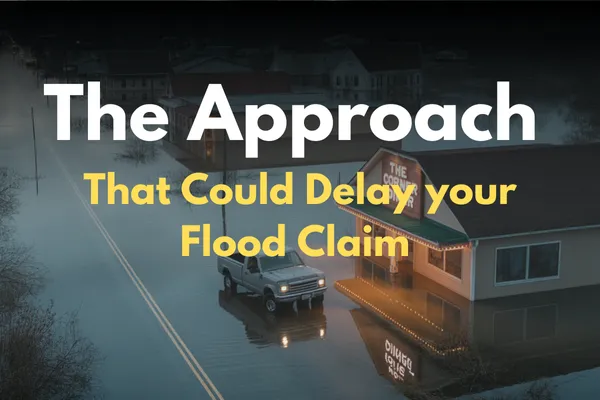Newsletters

The contractor was fast. The invoice was clean. The claim? Delayed for weeks.
This is where most flood claims start to fall apart.
When it comes to flood insurance, the details matter — especially when it comes to your repair estimate.
🧾 You may be used to seeing contractors or homeowners insurance carriers accept lump sum estimates.
But under the NFIP, that approach could delay your claim — or worse, reduce your payout entirely.
The Common Mistake That Slows Down Flood Claims
One of the most common mistakes I see after a flood?
Property owners or contractors submit a single total price for repairs.
Maybe it’s on an invoice. Maybe it’s in a contractor bid.
It might even say something like:
“Total for repairs: $84,500”
That might work fine under a homeowners policy.
But for flood insurance claims filed through the National Flood Insurance Program (NFIP) — that’s a problem.
NFIP claims require itemized, line-by-line estimates.
If the estimate isn’t detailed enough, the carrier can:
❌ Delay the claim review
❌ Request a new breakdown
❌ Rely solely on their own estimate — and pay you less than expected
What “Itemized” Really Means in a Flood Claim
The NFIP wants to know exactly what was damaged and exactly what it will cost to fix — by component and trade.
Here’s what a proper itemized estimate should include:
Framing – Square footage, type of wood, per-foot cost
Insulation – Material, location (walls, ceiling), R-value
Electrical – Fixtures replaced, rewiring, per unit
Drywall – Sheets, size, labor to hang and finish
Paint – Areas painted, coats applied, materials
Labor – Broken out by trade: electrical, plumbing, drywall, mitigation, etc.
Each item should include:
✔️ Quantities
✔️ Unit costs
✔️ Descriptions tied to the actual flood damage
This isn’t about paperwork — it’s about validating the loss and ensuring FEMA has no reason to delay your payment.
Why the NFIP Requires This
FEMA doesn’t just write checks — they verify claims against policy language, pricing guidelines, and required documentation.
Here’s what happens when your estimate isn’t properly itemized:
🕒 Delays — The carrier pauses your claim while asking for clarification or updated documentation.
💸 Payout reductions — If they don’t have the breakdown, they may pay based on their internal estimate instead of your contractor’s.
😓 Frustration — You’re stuck in limbo while trying to answer back-and-forth requests that could’ve been prevented.
You lose time. You lose control.
And in many cases, you lose money — simply because the format was wrong.
down the repair scope by trade
✅ Each line includes quantities, unit pricing, and clear descriptions
✅ The work aligns with flood damage — not unrelated improvements or upgrades
You don’t have to become an NFIP expert — but you do need to speak their language if you want your claim processed smoothly.
Final Word:
FEMA doesn’t pay based on assumptions.
They pay based on proof — and the strongest proof you can submit is a well-organized, itemized estimate that aligns with the NFIP policy requirements.
It’s not just about getting the work done.
It’s about getting paid for the work you’ve done.

